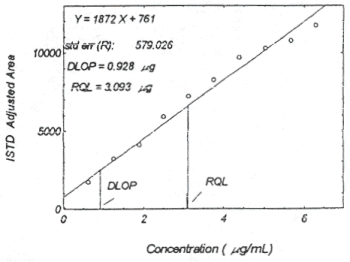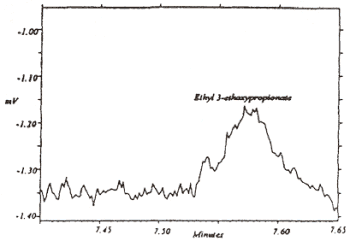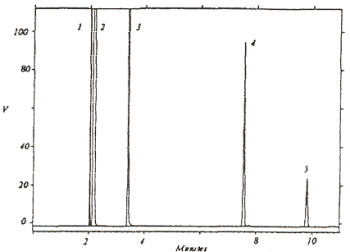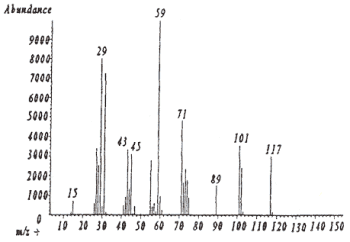
ETHYL 3-ETHOXYPROPIONATE
| Method number: | PV2025 |
| Matrix: | Air |
| Target concentration: | 25 ppm (149 mg/m3) |
| Procedure: | Ethyl 3-ethoxypropionate (EEP) samples are collected by drawing a known volume of air through a charcoal tube. Samples are desorbed with 1 mL of 99:1 carbon disulfide:dimethyl formamide (CS2:DMF) for 30 minutes with intermittent shaking and analyzed by gas chromatography using a flame ionization detector (GC-FID). |
| Recommended air volume and sampling rate: |
10 L at 0.1 L/min |
| Reliable quantitation limit: | 0.052 ppm (0.309 mg/m3) |
| Status of method: | Partially Evaluated Method. This method has been subjected to established evaluation procedures, and is presented for information and trial use. |
| Date: October 1995 | Chemist: Karl Walker |
Organic Service Branch I
OSHA Salt Lake Technical
Center
Salt Lake City, UT 84165-0200
1. General Discussion
- 1.1 Background
- 1.1.1 History
The desorption efficiency of EEP has been determined to be >99% from coconut charcoal with 99:1 carbon disulfide:dimethyl formamide (CS2:DMF) (Ref. 5.1). This study was performed to determine the retenetion and storage studies needed for a stop-gap or partially evaluated method. As of 7/28/95, the OSHA SLTC has received 102 samples requesting analysis for EEP.
1.1.2 Toxic effects (This section is for information only and should not be taken as the basis of OSHA policy) (Ref. 5.2, 5.3, 5.4, 5.5, 5.6).
The following toxic effects were listed by MDL Information Systems, Inc. (Ref. 5.4).
- Inhalation: If substantial amounts of EEP are inhaled, central
nervous system depression with headache, dizziness and drowsiness
may occur. Repeated exposure in rats causes lethargy.
Skin Contact: Contact with skin may cause irritation with redness. A relatively large amount was lethal to rabbits tested. Repeated or prolonged exposure may cause dermatitis.
Eye Contact: Contact with eyes may cause irritation with redness and tearing. Repeated or prolonged exposure may cause conjunctivitis.
Ingestion: Ingestion may cause nausea, vomiting, and central nervous system depression with dizziness, headache, weakness, drowsiness, and unconsciousness. Esters, in general, may pose an aspiration hazard causing chemical pneumonitis.
LD50: 5 gm/kg skin-rabbit; 3.2 gm/kg oral-rat
Exposure Limits: Eastman Kodak Company has established a health protection guide of 50 ppm TWA and 100 ppm STEL (Ref. 5.2, 5.3).
1.1.3 Workplace exposure (Ref. 5.4, 5.5, 5.6)
National Occupational Exposure Survey (1983) (NOES) gives the following Occupational Exposure Survey Data (NIOSH)
No. of Facilities: 4669 (estimated)
No. of Industries:
40
No. of Occupations: 34
No. of Employees: 42611
(estimated)
No. of Female Employees: 5944 (estimated)
EEP is used for coatings, inks, toners, paints, enamels, strippers, solvents, vitamin B preparation, manufacture of chemicals.
1.1.4 Physical properties and other descriptive information (Ref. 5.2 through 5.5)
| Synonyms: | Ethoxypropionic acid, ethylester;
Ethyl |
| CAS number: | 763-69-9 |
| IMIS: | E105 |
| RTECS: | UF3325000 |
| DOT: | UN1993 |
| Molecular weight: | 146.21 |
| Flash point: | 82°C (180°F) open cup |
| Boiling point: | 170°C |
| Melting point: | -58°C |
| Odor: | mild ester |
| Color: | colorless liquid |
| Autoignition Temperature: | 377°C (711°F) |
| Density: | 0.9496 (20°C) |
| Molecular formula: | C7H14O3 |
| Structural formula: |  |
The analyte air concentrations throughout this method are based on the recommended sampling and analytical parameters. Air concentrations listed in ppm are referenced to 25°C and 101.3 kPa (760 mm Hg).
- 1.2 Limit defining parameters
- 1.2.1 Detection limit of the overall
procedure (DLOP)
The detection limit of the overall procedure is 0.928 µg per sample (0.0155 ppm or 0.0928 mg/m3). This is the amount of analyte spiked on the sampler that will give a response that is significantly different from the background response of a sampler blank.
The DLOP is defined as the concentration of analyte that gives a response (YDLOP) that is significantly different (three standard deviations (SDBR)) from the background response (YBR).
The direct measurement of YBR and SDBR in chromatographic methods is typically inconvenient, and difficult because YBR is usually extremely low. Estimates of these parameters can be made with data obtained from the analysis of a series of samples whose responses are in the vicinity of the background response. The regression curve obtained for a plot of instrument response versus concentration of analyte will usually be linear. Assuming SDBR and the precision of data about the curve are similar, the standard error of estimate (SEE) for the regression curve can be substituted for SDBR in the above equation. The following calculations derive a formula for the DLOP:

| Yobs | = | observed response |
| Yest | = | estimated response from regression curve |
| n | = | total no. of data points |
| k | = | 2 for a linear regression curve |
At point YDLOP on the regression curve
| YDLOP = A(DLOP) + YBR | A = analytical sensitivity (slope) |
therefore

Substituting 3(SEE) + YBR for YDLOP gives

The DLOP is measured as mass per sample and expressed as equivalent air concentrations, based on the recommended sampling parameters. Ten samplers were spiked with equal descending increments of analyte, such that the highest sampler loading was 6.29 µg/sample. This is the amount, when spiked on a sampler, that would produce a peak approximately 10 times the background response for the sample blank. These spiked samplers, and the sample blank were analyzed with the recommended analytical parameters, and the data obtained used to calculate the required parameters (A and SEE) for the calculation of the DLOP. Values of 1872 and 579.026 were obtained for A and SEE respectively. DLOP was calculated to be 0.928 µg/sample (0.0155 ppm or 0.0928 mg/m3).
Detection Limit of the Overall Procedure
|
|
|
| mass per
sample (µg) |
area
counts (µV-s) |
|
| |
| 0 0.63 1.26 1.89 2.50 3.13 3.76 4.38 5.03 5.66 6.29 |
0 1743 3226 4124 5929 7218 8248 9715 10290 10775 11743 |
|
| |

Figure 1.2.1 Plot of data to determine the DLOP/RQL.
1.2.2 Reliable quantitation limit (RQL)
The reliable quantitation limit is 3.09 µg per sample (0.052 ppm). This is the amount of analyte spiked on a sampler that will give a signal that is considered the lower limit for precise quantitative measurements.
The RQL is considered the lower limit for precise quantitative measurements. It is determined from the regression line data obtained for the calculation of the DLOP (Section 1.2.1), providing at least 75% of the analyte is recovered. The RQL is defined as the concentration of analyte that gives a response (YRQL) such that
therefore

The RQL is the lowest loading at which 75% of the analyte can be recovered as determined from the regression line of the plotted data.
RQL = 3.09 µg per sample (0.052 ppm or 0.309 mg/m3)
The recovery at this concentration was 98.5%. This value is based on the 75% recovery requirement.

Figure 1.2.3 Chromatogram of the RQL.
2. Sampling Procedure
- 2.1 Apparatus
- 2.1.1 Samples are collected using a personal sampling pump
calibrated, with the sampling device attached, to within ±5% of the
recommended flow rate.
2.1.2 Samples are collected with 7 cm × 4 mm i.d. × 6 mm o.d. glass sampling tubes packed with two sections of coconut shell charcoal, lot 120. The front section contains 100 mg and the back section contains 50 mg of charcoal. The sections are held in place with glass wool plugs and are separated by a urethane foam plug. For this evaluation, commercially prepared sampling tubes were purchased from SKC West Inc., Fullerton, CA, Catalog No. 206-01, Lot 120.
2.2 Technique
- 2.2.1 Immediately before sampling, break off the ends of the
sampling tube. All tubes should be from the same lot.
2.2.2 Attach the sampling tube to the pump with flexible tubing. It is desirable to utilize sampling tube holders which have a protective cover to shield the employee from the sharp, jagged end of the sampling tube. Position the tube so that sampled air passes through the front section of the tube first.
2.2.3 Air being sampled should not pass through any hose or tubing before entering the sampling tube.
2.2.4 Attach the sampler vertically with the front section pointing downward, in the worker's breathing zone, and positioned so it does not impede work performance or safety.
2.2.5 After sampling for the appropriate time, remove the sample and seal the tube with plastic end caps. Wrap each sample end-to-end with a Form OSHA-21 seal.
2.2.6 Submit at least one blank sample with each set of samples. Handle the blank sampler in the same manner as the other samples except draw no air through it.
2.2.7 Record the sample volumes (in liters of air) for each sample, along with any potential interferences.
2.2.8 Ship any bulk samples separate from the air samples.
2.2.9 Submit the samples to the laboratory for analysis as soon as possible after sampling. If delay is unavoidable, store the samples in a refrigerator.
2.3 Desorption efficiency
The desorption efficiencies of EEP were determined by liquid-spiking the 6 tubes with the analytes at 0.1 to 2 times the target concentration. The loadings on the tubes were 157, 787, 1573, and 3146 µg of EEP. These samples were stored overnight at ambient temperature and then desorbed and analyzed. The average desorption efficiency over the studied range was 99.2%.
Desorption Efficiency of EEP
|
| ||||
| Tube # | % Recovered | |||
| 0.1 × µg | 0.5 × µg | 1.0 × µg | 2.0 × µg | |
|
| ||||
| 1 2 3 4 5 6 |
99.6 99.8 98.0 98.4 98.3 98.0 |
98.6 97.9 98.5 98.3 99.1 98.2 |
99.2 99.4 98.9 99.9 99.9 101.1 |
98.7 100.0 98.8 101.9 98.2 101.5 |
| average | 98.7 | 98.4 | 99.7 | 99.9 |
| overall average |
99.2 | |||
| standard deviation |
± 1.1 | |||
|
| ||||
2.4 Retention efficiency
The sampling tubes were spiked with 1573 µg (26.3 ppm) EEP, allowed to equilibrate for 12 hours at room temperature, and then had 10 L humid air (80% RH at 21.5°C) pulled through them at 0.1 Lpm. They were opened, desorbed, and analyzed by GC-FID. The retention efficiency averaged 97.6%. There was no EEP found on the back sections of the tubes.
Retention Efficiency of EEP
|
| ||||
| Tube # | % Recovered | |||
| Front Section | Back Section | Total | ||
|
| ||||
| 1 2 3 4 5 6 |
97.0 97.7 98.4 97.2 98.3 97.0 |
0 0 0 0 0 0 average |
97.0 97.7 98.4 97.2 98.3 97.0 97.6 | |
|
| ||||
2.5 Sample storage
The front sections of six sampling tubes were each spiked with 1573 µg (26.3 ppm) of EEP. Six more tubes had 10 liters of humid air (80% RH at 21.5°C) drawn through them before they were spiked with 1573 µg (26.3 ppm) of EEP. They were sealed and stored at room temperature. Three of each type of samples were analyzed after 7 days and the remaining three samples of each type after 14 days. The amounts recovered indicate good storage stability for the time period studied and had an average recovery of 94.4%.
Storage Test for EEP
|
| ||
| Time (days) |
Recovery Humid (%) |
Recovery Dry (%) |
|
| ||
| 7 14 average |
91.0 90.9 91.8 92.1 92.5 92.0 91.7 |
98.1 98.7 95.8 95.4 96.0 98.0 97.0 |
|
| ||
2.6 Recommended air volume and sampling rate.
Based on the data collected in this evaluation, 10 L air samples should be collected at a sampling rate of 0.1 L/min.
2.7 Interferences (sampling)
- 2.7.1 It is not known if any compounds will severely interfere
with the collection of EEP on the sampling tubes. In general, the
presence of other contaminants in the air will reduce the capacity
of the charcoal tube to collect EEP.
2.7.2 Suspected interferences should be reported to the laboratory with submitted samples.
2.8 Safety precautions (sampling)
- 2.8.1 Attach the sampling equipment to the worker in such a
manner that it will not interfere with work performance or safety.
2.8.2 Follow all safety practices that apply to the work area being sampled.
2.8.3 Wear eye protection when breaking the ends of the glass sampling tubes.
3. Analytical Procedure
- 3.1 Apparatus
- 3.1.1 The instrument used in this study was a gas chromatograph
equipped with a flame ionization detector, specifically a
3.1.2 A GC column capable of separating the analyte from any interferences. The column used in this study was a DB-5, 60 meter by 0.32 mm i.d. capillary column coated with a 1.0 µm film.
3.1.3 An electronic integrator or some suitable method of measuring peak areas.
3.1.4 Two milliliter vials with TeflonTM-lined caps.
3.1.5 A 10-µL syringe or other convenient size for sample injection.
3.1.6 Pipets for dispensing the desorbing solution. A repipet dispenser was used in this study.
3.1.7 Volumetric flasks - 5 or 10 mL and other convenient sizes for preparing standards.
3.2 Reagents
- 3.2.1 GC grade nitrogen, hydrogen and air.
3.2.2 Ethyl 3-ethoxypropionate, Reagent grade.
3.2.3 Carbon disulfide, Reagent grade.
3.2.4 Dimethyl formamide, Reagent grade.
3.2.5 p-Cymene, Reagent grade.
3.2.6 The desorbing solution was a mixture of 1:99 dimethyl formamide:carbon disulfide with 0.25 µL/mL p-cymene internal standard.
3.3 Standard preparation
- 3.3.1 At least two separate stock standards are prepared by
diluting a known quantity of EEP with the desorbing solution of 1:99
DMF:CS2 with 0.25 µL/mL p-cymene internal
standard. The concentration of these stock standards was 1 µL/mL or
949.6 µg/mL.
3.3.2 A third standard at a higher concentration was prepared to check the linearity of the calibration. For this study, two analytical standards were prepared at a concentration of 1 µL/mL (949.6 µg/mL), and one at 4 µL/mL (3798 µg/mL) EEP in the desorbing solution.
3.4 Sample preparation
- 3.4.1 Sample tubes are opened and the front and back section of
each tube are placed in separate 2 mL vials.
3.4.2 Each section is desorbed with 1 mL of the desorbing solution of 1:99 DMF:CS2 with 0.25 µL/mL p-cymene internal standard.
3.4.3 The vials are sealed immediately and allowed to desorb for 30 minutes with intermittent shaking.
3.5 Analysis
- 3.5.1 Gas chromatograph conditions.
| Injection size: | 1 µL |
| Flow rates (mL/min) | |
| Nitrogen (make-up): | 31.2 |
| Hydrogen (carrier): | 2.0 |
| Hydrogen (detector): | 29.6 |
| Air: | 389 |
| Temperatures (°C) | |
| Injector: | 200 |
| Detector: | 220 |
| Column: | 100 |

Figure 3.5.1 Chromatogram at the target concentration.
The peaks are identified as follows:
| (1) isopropanol (2) carbon disulfide (3) dimethyl formamide (4) ethyl 3-ethoxypropionate (5) p-cymene |
3.5.2 Peak areas are measured by an integrator or other suitable means.
3.6 Interferences (analytical)
- 3.6.1 Any compound that produces a response and has a similar
retention time as the analyte is a potential interference. If any
potential interferences were reported, they should be considered
before samples are desorbed. Generally, chromatographic conditions
can be altered to separate an interference from the analyte.
3.6.2 When necessary, the identity or purity of an analyte peak may be confirmed by GC-mass spectrometer or by another analytical procedure.

Figure 3.6 A mass spectra of ethyl 3-ethoxypropionate.
3.7 Calculations
- 3.7.1 The instrument was calibrated with a standard of 949.6
µg/mL EEP in the desorbing solution. The linearity of the
calibration was checked with a standard of 3798 µg/mL (63.5 ppm).
3.7.2 If the calibration is non-linear, two or more standards at different concentrations must be analyzed, bracketing the samples, so a calibration curve can be plotted and sample values obtained.
3.7.3 To calculate the concentration of analyte in the air sample the following formulas are used:
| (µg/mL) (desorption
volume) (desorption efficiency) |
= mass of analyte in sample |
| (mass of analyte in
sample) molecular weight |
= number of mole of analyte |
| ( | number of moles of analyte | ) | ( | molar volume at
|
) | = | ( | volume the analyte will occupy
at |
) |
| (volume analyte occupies)
(106)* (air volume) |
= ppm |
* All units must cancel.
3.7.4 The above equations can be consolidated to the following formula.
| (µg/mL) (DV)
(24.46) (106) (g) (mg) (10 L) (DE) (MW) (1000 mg) (1000 µg) |
= ppm |
| µg/mL | = | Concentration of analyte in sample or standard |
| 24.46 | = | Molar volume (liters/mole) at 25°C and 760 mm Hg |
| MW | = | Molecular weight (g/mole) |
| DV | = | Desorption volume |
| 10 L | = | 10 liter air sample |
| DE | = | Desorption efficiency |
3.7.5 This calculation is done for each section of the sampling tube and the results added together.
3.8 Safety precautions (analytical)
- 3.8.1 Avoid skin contact and inhalation of all chemicals.
3.8.2 Wear safety glasses, gloves and a lab coat at all times while in the laboratory areas.
4. Recommendations for Further Study
Collection studies need to be performed from a dynamically generated test atmosphere.
5. References
- 5.1 Desorption/Extraction Study for Ethyl
3-ethoxypropionate, OSHA SLTC, USDOL, Salt Lake City, UT 84165-0200.
5.2 MDL Information Systems, Incorporated, 14600 Catalina Street, San Leandro, CA 94577.
5.3 MSDS Eastman Kodak Company, 343 State Street, Rochester, NY 14650.
5.4 Registry of Toxic Effects of Chemical Substances in RTECS CD-ROM Disc 95-3, 1995-3, National Institute for Occupational Safety and Health, Center for Disease Control, Department of Health and Human Services, Washington, D.C.
5.5 Hawley, G.G., "The Condensed Chemical Dictionary, Twelfth Edition", Van Nostrand Reinhold Co., New York, N.Y. 1993 p. 492.
5.6 Trade names Database on CCINFO CD-ROM, Disc 95-2, Canadian Centre for Occupational Health and Safety, Hamilton, Ontario.